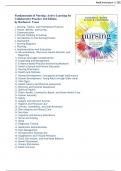Exam (elaborations)
Test Bank For Fundamentals of Nursing: Active Learning for Collaborative Practice 3rd Edition by Barbara L Yoost | Complete Guide A+
- Course
- Institution
- Book
Test Bank For Fundamentals of Nursing: Active Learning for Collaborative Practice 3rd Edition by Barbara L Yoost | Complete Guide A+
[Show more]



